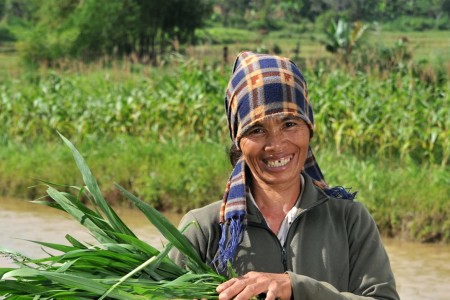It’s one of the classic problems in agricultural development: how to scale innovations to reach millions of smallholders on thin budgets? The unstoppable rise of the smartphone, data streaming, tiny ‘pico’ projectors and a renewed focus on farmer-to-farmer (FTF) approaches are breathing new life into a familiar strategy: video extension.

In Northern Vietnam I recently met a farmer who said his village specializes in growing stones. As the topsoil erodes away older residents have witnessed new stones rising to the surface. In August this same farmer participated in an exchange visit to nearby Van Yen district, where some producers have been using grass barriers for over 13 years to reduce soil erosion. The trip was a success, but the number of lucky people participating in these direct exchanges is limited. A method for farther-reaching, more cost-effective exchanges receiving renewed attention is FTF video.
Rather than describing research results, FTF video encourages individuals to illustrate key concepts by describing their own experiences in everyday language. In this way decades of research forms the foundational core backing the content, but it is end users steeped in both knowledge and experience who take the spotlight as presenters.
Smartphone subscriptions reached 224 million in Southeast Asia & Oceania by the end of 2014, with estimates of 800 million subscribers by 2020 as device prices plummet. The total number of people with unsubscribed media-capable devices is much higher. Tiny, powerful pico projectors enable workshop or village-level viewing without costly and bulky external power sources. Gone are the bulky multimedia carts of yore. Video extension is increasingly no longer constrained to shepherding participants around a screen for one-time viewing, and the old promise of FTF video is getting a second wind.
Common misunderstandings are that video is easy (just show up and hit record!) or that it is anecdotal and unscientific. The reality is that good FTF videos seem effortless to the viewer only as a result of exhaustive background research. The best videos distill the results of formal research through illustrative, real-world cases; a process requiring equal parts understanding of the underlying science, careful identification of advanced adopters and progressive farmers, and skilful interviewing and editing.
Research has shown that FTF video can be effective even in cross-cultural settings as diverse as bridging South Asia and sub-Saharan Africa. In some cases FTF video is also able to circumvent barriers in local power structures, better reaching marginalized segments of society relative to the participant selection processes of traditional workshops. In low-literacy environments it is difficult to overstate the impact of well-designed visual demonstrations, and the level of confidence in the information presented is typically high in FTF interactions.
The International Center for Tropical Agriculture (CIAT) in Asia has recently partnered with Agro-Insight, an enterprise specializing in FTF video and extension work in agriculture, to use FTF video to attack key production constraints in the cassava cropping system. Agro-insight has a long history working with CGIAR, including productions with CIMMYT, ICRISAT and CIAT. They are also recipients of the CGIAR science award for outstanding communications. Most recently the team reached out to cassava farmers across North Vietnam and Southern Thailand to tell their stories about soil fertility and how they are facing the challenge of maintaining production while saving soils.
The two resulting videos will be launched at FAO’s World Food Day events in Lao Cai, Vietnam, and Vientiane, Laos. Coinciding with the international year of soils all videos will be hosted on online streaming services including CGSpace and the popular Access Agriculture platform, making them free on demand for Southeast Asian farmers to enjoy in English, Vietnamese, Thai, Khmer and Lao.
Parallel work is ongoing to measure the impact of these video products as they propagate throughout the region. How do farmers use and share these materials, and how many do they reach? Answering these questions is critical to understanding the contextual impact of FTF. As connectivity and access to technical information improves, it is critical to ensure that this information be made available in a palatable format tailored to smallholders’ learning styles.
Watch the video in English
Grass strips against soil erosion: This farmer-to-farmer video, developed through funding by the Swiss Agency for Development and Cooperation, explains in a clear and simple way the agricultural technique to plant grass strips on sloping land to prevent soil erosion.
Growing cassava on sloping land in English: This farmer-to-farmer video also developed through funding by the Swiss Agency for Development and Cooperation (SDC) by CIAT and Agro-Insight, explains in a clear and simple way how to cultivate and manage cassava while preventing soil erosion on sloping land.
The video will be published in five languages. For access or more information, please email g(dot)smith(at)cgiar(dot)org. The Vietnamese version is below.
Watch the videos in Vietnamese
Grass strips against soil erosion in Vietnamese: https://youtu.be/WKokHpMNgb0
Growing cassava on sloping land in Vietnamese: https://youtu.be/2E_e8WUjEzo

















